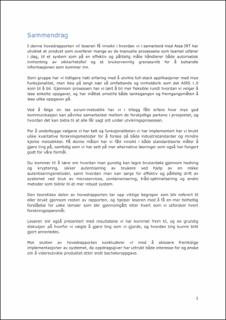| dc.contributor.advisor | Skundberg, Olav | |
| dc.contributor.author | Hadzalic, Endré | |
| dc.contributor.author | Kvarving, Odin | |
| dc.contributor.author | Sonen, Scott Rydberg | |
| dc.date.accessioned | 2022-07-02T17:20:17Z | |
| dc.date.available | 2022-07-02T17:20:17Z | |
| dc.date.issued | 2022 | |
| dc.identifier | no.ntnu:inspera:111604085:111608673 | |
| dc.identifier.uri | https://hdl.handle.net/11250/3002387 | |
| dc.description.abstract | I denne hovedrapporten vil leseren få innsikt i hvordan vi i samarbeid med Atea IRT har utviklet et produkt som overfører mange av de manuelle prosessene som teamet utfører i dag, til et system som på en effektiv og pålitelig måte håndterer både automatisk innhenting av sikkerhetsfeil og et brukervennlig grensesnitt for å behandle informasjonen som kommer inn.
Som gruppe har vi tidligere hatt erfaring med å utvikle full-stack applikasjoner med mye funksjonalitet, men ikke på langt nær så omfattende og innholdsrik som det AIRS 1.0 kom til å bli. Gjennom prosessen har vi lært å bli mer fleksible rundt hvordan vi velger å løse enkelte oppgaver, og har måttet omstille både tankegangen og fremgangsmåten å løse ulike oppgaver på.
Ved å følge en løs scrum-metodikk har vi i tillegg fått erfare hvor mye kommunikasjon kan påvirke samarbeidet mellom de forskjellige partene i prosjektet, og hvordan det kan bidra til at alle får sagt sitt under utviklingsprosessen.
For å underbygge valgene vi har tatt og funksjonaliteten vi har implementert har vi brukt ulike kvalitative forskningsmetoder for å forske på både industristandarder og mindre kjente metodikker. På denne måten har vi fått innsikt i både standardiserte måter å gjøre ting på, samtidig som vi har sett på mer alternative løsninger som også har fungert godt for våre formål.
Du kommer til å lære om hvordan man gunstig kan lagre brukerdata gjennom hashing og kryptering, sikker autentisering av brukere ved hjelp av en rekke autentiseringsmetoder, samt hvordan man kan sørge for effektiv og pålitelig drift av systemet ved bruk av microservices, containerisering, tråd-optimalisering og andre metoder som bidrar til et mer robust system.
Den teoretiske delen av hovedrapporten tar opp viktige begreper som blir referert til eller brukt gjennom resten av rapporten, og hjelper leseren med å få en mer helhetlig forståelse for ulike temaer som blir gjennomgått etter hvert som vi utforsker hvert forskningsspørsmål.
Leseren blir også presentert med resultatene vi har kommet frem til, og en grundig diskusjon på hvorfor vi valgte å gjøre ting som vi gjorde, og hvordan ting kunne blitt gjort annerledes.
Mot slutten av hovedrapporten konkluderer vi med å skissere fremtidige implementasjoner av systemet, da oppdragsgiver har uttrykt både interesse for og ønske om å videreutvikle produktet etter endt bacheloroppgave. | |
| dc.description.abstract | In this main-report the reader will get a good look into how we, in cooperation with Atea IRT, managed to develop a product that transforms many of the manual tasks they’re performing today - into a system that effectively and reliably handles both automatic retrieval of security-issues and a user-friendly interface for interacting with the information on the platform.
As a group we have had experience with developing full-stack applications with a lot of functionality, but nothing comes close to the rich amount of content that would be applied to AIRS 1.0. Throughout the process we have learned to become more flexible around how we choose to solve different tasks, while having to completely rewire both our thought-process and approach to solving these tasks in a satisfying manner.
By following a loosely-based scrum-methodology we have also had the chance to experience exactly how much communication can affect the cooperation between the different stakeholders in the project, and how it can contribute to everyone having a say in what happens during the development of the product.
To substantiate the choices we have made and the functionality that we have implemented, we have used different kinds of qualitative research processes to learn more about both industry-standards and lesser known methodologies. In this way, we have had a chance to get a good look into both standardized ways of doing things, and also learning more alternative methods for solving these same tasks, which turned out to work great for our purposes.
You will learn how to conveniently store user-data through hashing and encryption, secure authentication of users by utilizing different kinds of authentication-methods, and also how to ensure an effective and reliable system through the use of microservices, containerizing, thread-optimisation and other methods which contributes to a more robust system.
The theoretical part of the main-report brings up important concepts that are referred to and used throughout the rest of the report, and helps the reader with obtaining a more broad understanding of the different themes that are reviewed during our run-through of the different research-questions.
The reader will be presented with the results that we have produced, and a thorough discussion on why we chose to solve things the way that we did, and what could have been done differently.
Towards the end of the main-report we conclude our work by presenting future implementations of our system, based on both the interest and wishes from our task-provider for the product after the end of our bachelor thesis. | |
| dc.language | nob | |
| dc.publisher | NTNU | |
| dc.title | Incident Response System | |
| dc.type | Bachelor thesis | |
